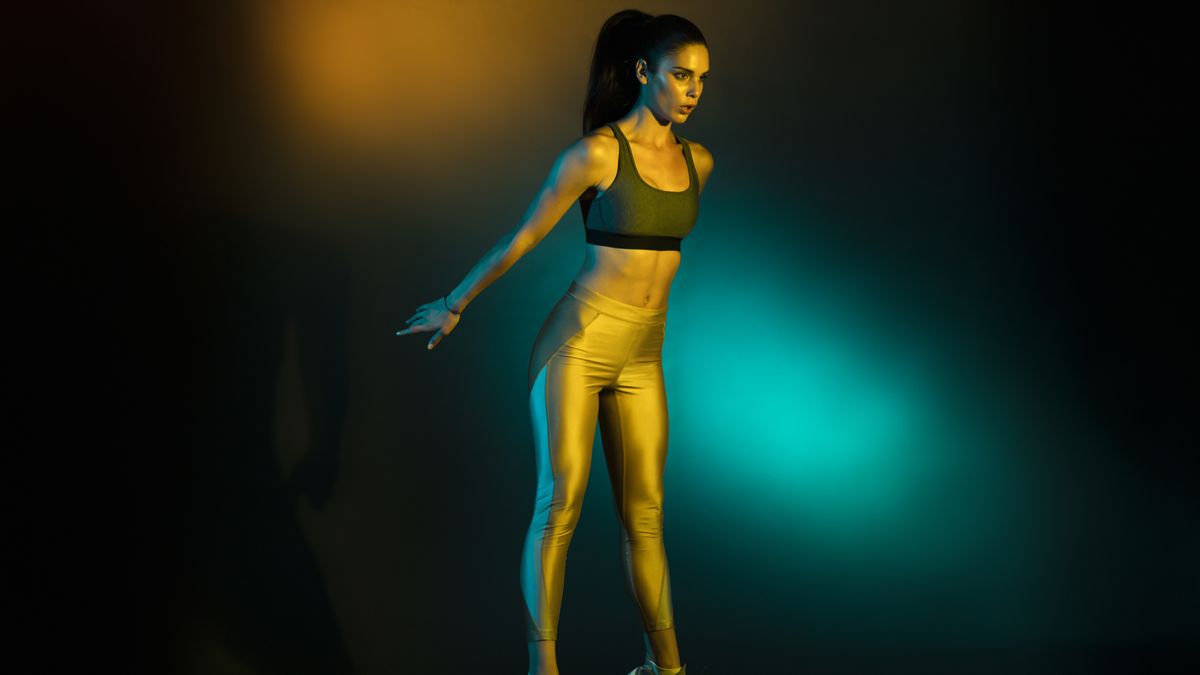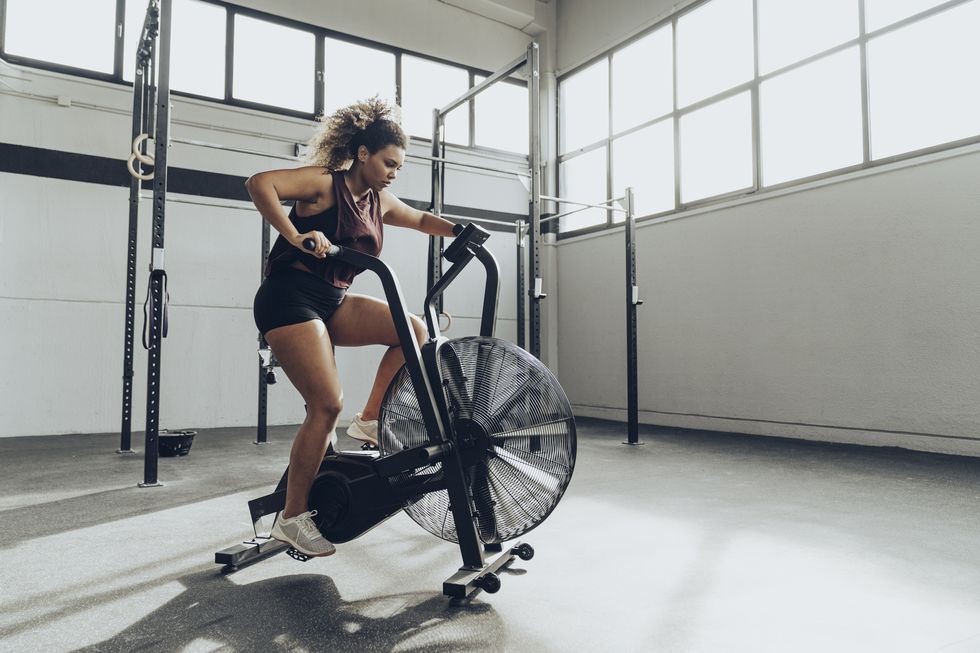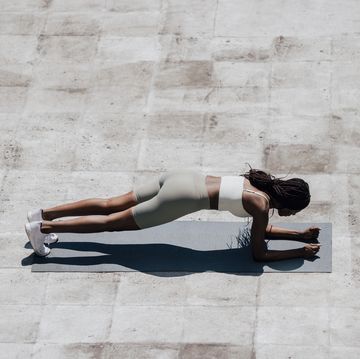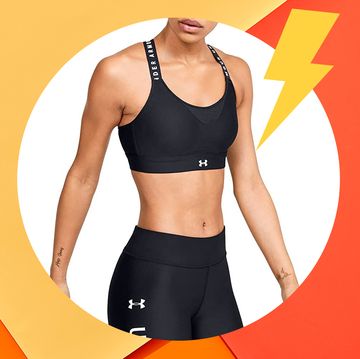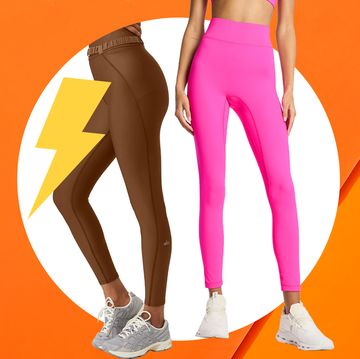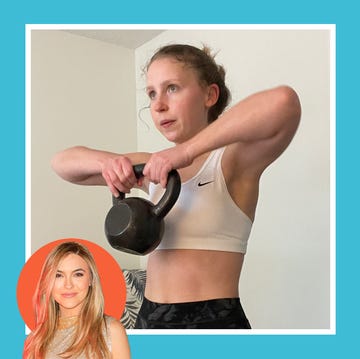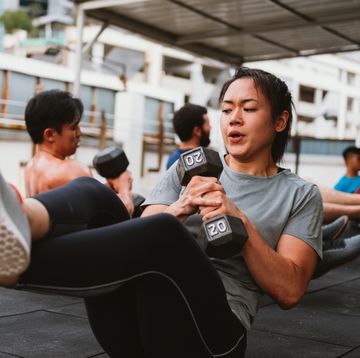When I'm planning my fitness routine, my goal is not to spend as much time as possible sweating. It's exactly the opposite. I want to be ultra-efficient in the gym or my living room and get on with my day. (Proof: My copy of the book Run Less, Run Faster is well loved.) Enter: HIIT, or high-intensity interval training.
HIIT’s definition is way more simple than you might think, says Annie Mulgrew, founding instructor for CITYROW in New York City and NASM-certified CPT. “High-intensity interval training is a form of interval training that alternates between short bursts of intense energy or activity followed by minimal rest, ideally until that person is unable to continue,” she explains.
Meet the expert: Annie Mulgrew, CPT, is the founding instructor for CITYROW in New York City and NASM-certified personal trainer.
7 Benefits Of HIIT
1. HIIT burns a boatload of calories—even after you’ve finished working out.
Although aerobic exercise is a great tool in maintaining your heart health, as far as weight loss tactics go, that steady-state run isn’t the best calorie-burner. And while weight training is typically the most reliable weight loss tactic when it comes to fitness type (remember though, weight loss is achieved through a calorie deficit, which is most easily achieved through diet), if there is one form of cardio that blasts calories, it’s HIIT.
One 2015 study (of healthy men) that compared calorie burn after 30 minutes of HIIT to other forms of steady-state exercise noted that HIIT burned 25 to 30 percent more calories. Other studies (also on men) have noted that HIIT propels your production of human growth hormone, or HGH, upwards of 450 percent in the 24 hours following a session, increasing overall calorie burn.
2. HIIT may help you change your body composition quicker compared to other workout types (especially around the midsection).
Yep—a study in Journal of Diabetes Research confirmed this. The researchers divided obese, sedentary women into groups: those who partook in a HIIT program and those who did a moderate-intensity (but continuous energy expenditure) routine. The former group achieved similar body composition and aerobic capacity results in half the time.
3. HIIT workouts can include simple, beginner-friendly moves.
One major (assumed) drawback to HIIT, of course, is the notion you need to be flying, flailing, bounding, and sprinting (with a series of complicated tools, no less) in order to achieve a solid workout. But as Mulgrew points out, the hallmark of HIIT lies in exertion, not the modality, so pretty much any form of exercise fits—and that includes the simplest form of cardio there is: walking.
In one Japanese study, for five months, 700 middle- and older-aged adults engaged in walking intervals (shorter bursts of speed interspersed with periods of rest). At the conclusion of the study, the individuals had noticeably improved endurance and strength.
4. HIIT gives you a mental boost.
Studies have shown that regular HIIT exercise can boost your memory and make you sharper in everyday decision-making. One (potential) reason why, according to Mulgrew: “During a HIIT workout, you have to stay focused,” she explains.
5. It’s an efficient and fast workout.
You don’t have to sweat for very long in order to see results. In fact, it's just as effective to do a shorter interval session than a long moderate workout. A 2006 study compared two groups of college men for two weeks: those who did stationary bicycling at a moderate pace for roughly an hour-and-a-half to two hours for three times a week, and those who did six 30-second all-out sprints with four minutes of recovery.
Surprise, surprise: The HIIT-ers were just as fit (in terms of exercise performance and muscle growth) as those moderate-intensity exercisers by the end of the trial—with far less time invested.
6. HIIT helps build muscle.
While resistance training is the gold standard for building muscle, HIIT workouts can spur muscle growth as well. Whatever areas of the body your HIIT exercises focus on is where you're likely to see the muscle definition (most often the core and legs).
7. HIIT can lower blood pressure and blood sugar levels.
There are multiple studies to support this boost in overall health. One caveat: The benefit is limited to those above the "normal" BMI range.
What is high-intensity interval training (HIIT) exactly ?
You can actually tap into those HIIT benefits with a wide range of workouts. HIIT can be just about anything—from swimming to running to mountain climbers in your apartment to even weight training. The key, Mulgrew says, is ensuring that the “short burst of energy” is at least 80 percent of your maximum effort (so, 8+ on a scale of 10 for your RPE). You get the benefits of regular aerobic exercise (a boost in heart health, blood sugar levels in check, and healthy minds) and then some.
“For HIIT to be effective, your ‘on’ intervals need to be all-out,” she says. Mulgrew also notes that your rest period shouldn’t exceed your active period (try, 20 seconds on and 10 seconds off). That rest period can contain no movement or moderate-effort movement—that part really isn’t important, she says. Those maximum-effort bursts are where the gains are made, Mulgrew reiterates.
In Mulgrew’s CITYROW classes, for example, that on/off scheme translates to both meters rowed on the rowing machine, as well as resistance training off the rower. “You may find short rowing distance repeats or hip thrusters programmed as 40 seconds on and 20 seconds off,” she says.
Beginners should aim for no more than 20 minutes of HIIT total. And if you’re a total HIIT nut, limit yourself to 50 to 60 minutes (so the actual HIIT portion of the workout is around 30 minutes and the warm-up/cool-down roughly 20 minutes). “Going any longer than that would most likely mean you’re not able to maintain the intensity you need in order to achieve the benefits of a HIIT workout,” she says.
How To Get The Most From Your HIIT Workout
Here, Mulgrew shares her top tips for ensuring you blast through your next HIIT session.
- Prepare to go all-out. “Choose exercises that you know how to perform well and that you are able to perform at an intense level (again at least 80 percent intensity),” Mulgrew says. “Monitor rest and keep it strict.”
- Focus on your form. In that same vein, choosing exercises you know how to do well ensures you’re not attempting to move your body in a new (and potentially injuring-causing) position. When in doubt, keep the “burst” simple.
- Warm up extra well. Mulgrew recommends doing five to 10 (or more) minutes of dynamic stretching prior to jumping into a HIIT workout. “If you’re doing traditional cardio HIIT work, establish a baseline of intensities at 50 to 70 percent intensity, and then build from there,” she explains. “I always suggest doing the exercises you’ll perform during your HIIT workout, but non-loaded, so your body knows how to move well first before going at higher intensities.”
- Put your phone away. “HIIT requires you to be attentive and focused,” Mulgrew says. “You cannot get distracted. Otherwise, you will lose track of the clock. Use HIIT as a great way to give yourself your own full attention.”
- Grab a sustainable weight. Choose a weight that allows you to complete 10 to 20 reps repeatedly in your “on” periods, Mulgrew recommends.
- Optimize your time. Beginners should aim for no more than 20 minutes of HIIT total. And if you’re a total HIIT nut, limit your session to 50 to 60 minutes (so the actual HIIT portion of the workout is around 30 minutes and the warm-up/cool-down roughly 20 minutes). “Going any longer than that would most likely mean you’re not able to maintain the intensity you need in order to achieve the benefits of a HIIT workout,” Mulgrew says.

